Chapter 2: The Repository of Biological Information
1/93
There's no tags or description
Looks like no tags are added yet.
Name | Mastery | Learn | Test | Matching | Spaced |
|---|
No study sessions yet.
94 Terms
What is Genetics?
It is the science of heredity and the variation of inherited characteristics (pg. 24)
Who was Gregor Mendel?
He was a German Friar who in the 1850s studied pea plants and discovered the foundation of modern genetics (pg. 24-25)
What are gamete cells?
Sex cells. The cells that are come from parents to create offsrping e.g. sperm and egg in humans (pg. 24)
What are somatic cells?
All cells in an organism that aren't gametes (pg. 24)
What does purebred mean?
It means an individual is homozygous for an individual trait or traits (pg. 25)
What is the P generation?
The parental generation (pg. 25)
What does hybrid mean?
It refers to progeny resulting from a cross of parents with different genotypes (pg. 25)
What is the F1 generation?
Progeny resulting from cross in the P generation (sons and daughters). F stands for filial which is Latin for "daughter" (pg. 25)
What is a dominant allele? How is it represented?
The allele expressed in the phenotype of a heterozygous organism. It's represented with a capital letter. (pg. 27)
What is a recessive allele? How is it represented?
The allele that is masked in the phenotype of a heterozygous organism. It's represented with a lower case letter (pg. 25)
What is the F2 generation?
Progeny resulting from a cross in the F1 generation (pg. 25)
Summarize Mendel's experiment with the pea plants
He started with different pure bred (P generation) pea types and then cross polinated them. The offspring (F1 generation) all expressed dominant traits (all round, yellow, inflated, green, purple, axial, tall, etc.). He then cross polinated the F1 generation to create an F2 generation. The F2 generation showed a combination of dominant and recessive traits all exhibiting about a 3:1 ratio see table 2.1 (pg. 26)
What is a gene?
A section of DNA encoding a protein or functional RNA (pg. 26)

What does diploid mean?
It means a cell carries two copies of every gene, 2n. Somatic cells are diploid (pg. 26)
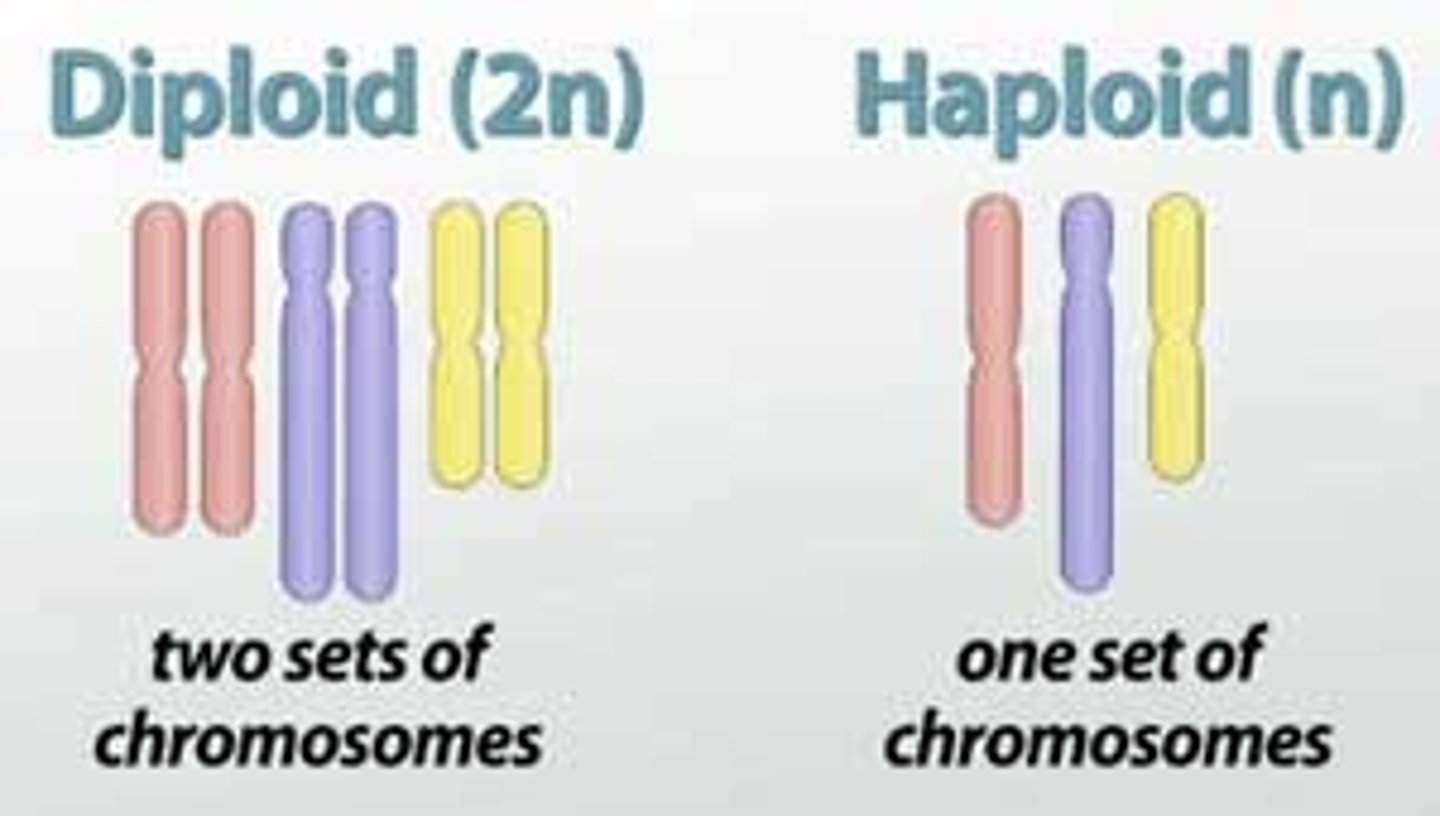
What are alleles?
A variant of a gene encoding a trait e.g. seed shape, color, height, etc. (pg. 26)
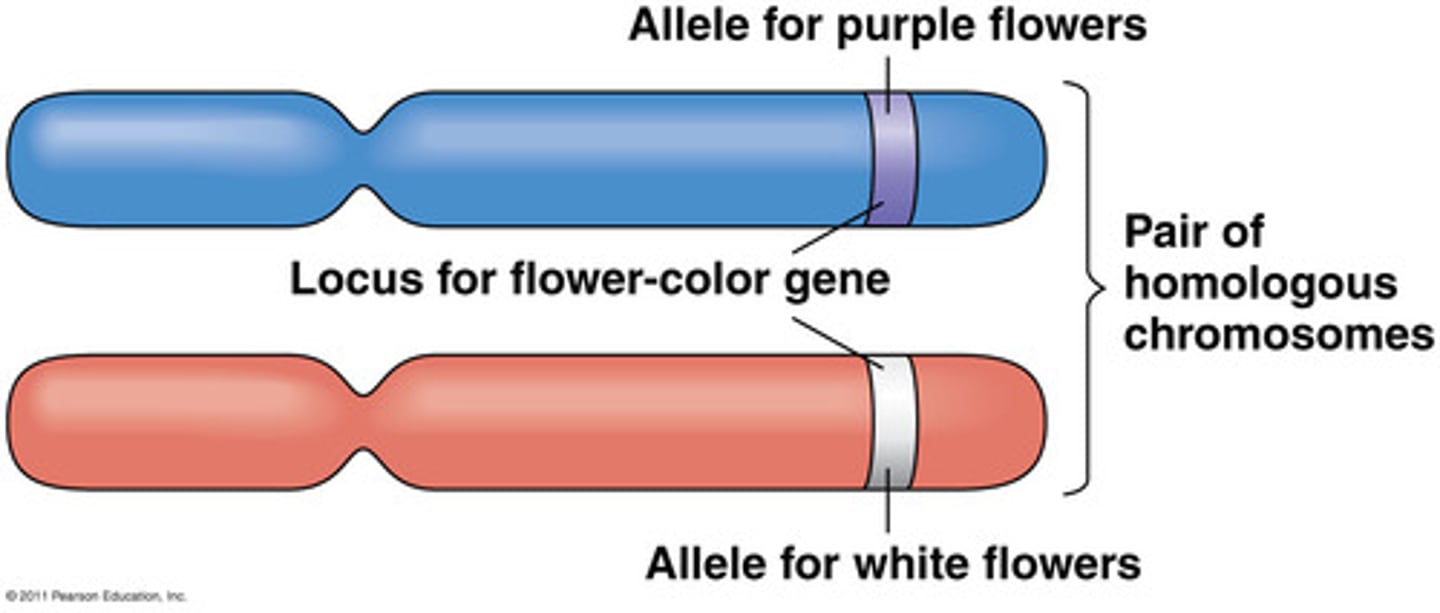
Define Phenotype
Phenotype is the outward appearance of an organism (pg. 26)
What does haploid mean?
It means the cell has only one copy of its genes, n. Gamete cells are haploid (pg. 26)
What is an organism's genotype?
It's the type of alleles contained in an organism. We represent it with a pair of uppercase and/or lowercase latters (RR/Rr/rr)(pg. 27)
What is a Punnett Square?
A figure that shows the possible genotypes of offspring given the genotype of the parents (pg. 27)

What does homozygous mean?
It means an organism has two identical copies of an allele for one gene. Can be either two dominant or two recessive alleles (RR/rr)(pg 27)
What does heterozygous mean?
It means an organism has both a dominant and recessive allele for a given gene (pg. 27)
Summarize Mendel's findings from his pea plant experiments.
Mendel hypothesized that traits are carried by particulate genes, that somatic cells contain two copies (two alleles) of each gene, and that gamete cells obtain only one allele for each gene during gamete formation. When two gametes fuse at fertilization, allele pairs are restored, producing the diploid genotype of the offspring (pg. 27-28)
What is Mendel's first law?
The law of segregation: equal and independent segregation of alleles occurs during formation of gamete cells. (pg. 28)
What does Mendel's first law predict?
Do Punnett squares for RRxrr and RrxRr. Or problems 1-3 on pg. 59 (see figure 2-2 pg. 28)

What is Mendel's second law?
Different genes assort independently during gamete formation. (pg. 28)
What predictions does Mendel's second law make?
It predicts that if we cross two organisms with RRYY and rryy genotypes that the first generation will have the dominant phenotypes and that the second generation will produce four phenotypes with a ratio of 9:3:3:1 (pg. 28)
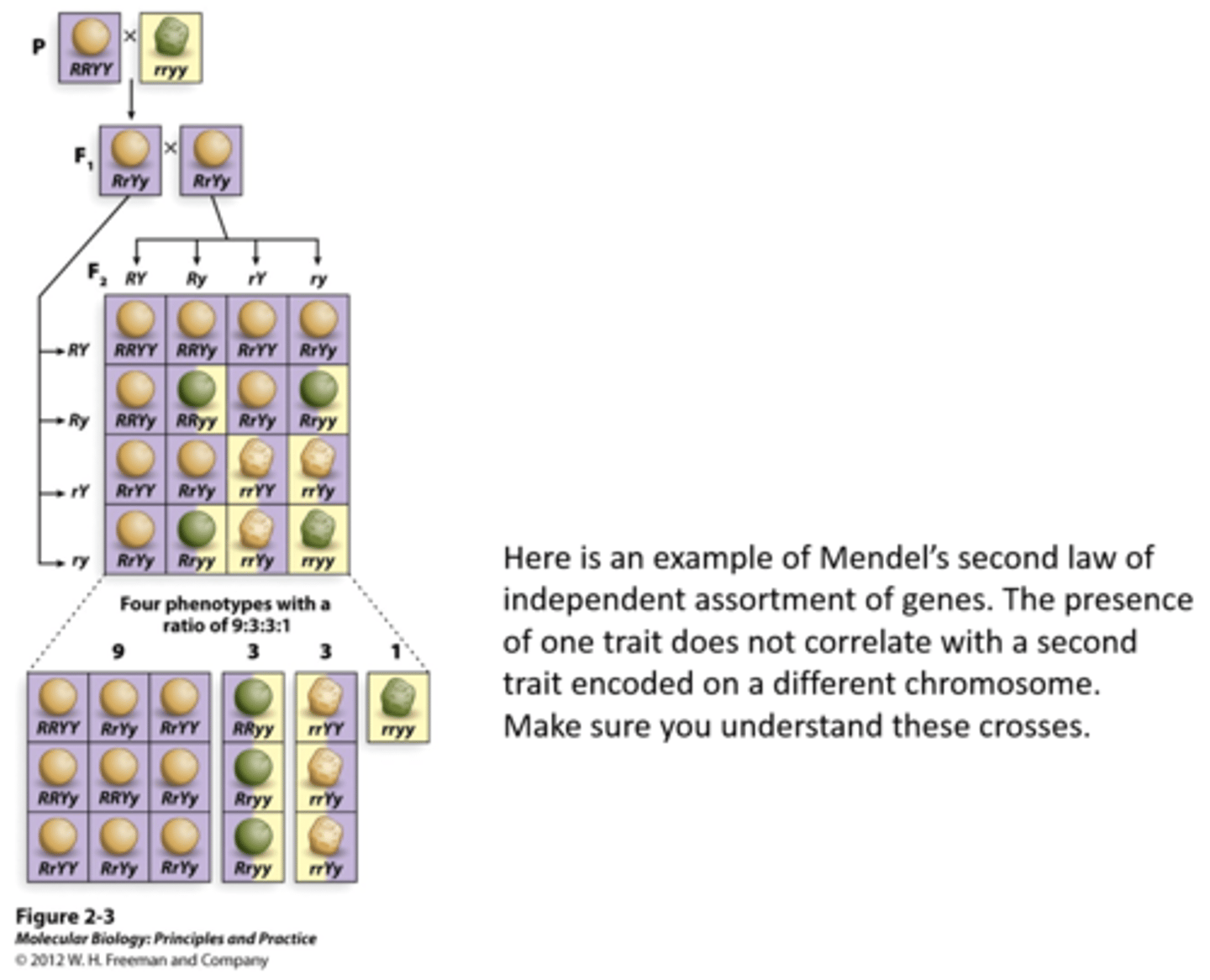
What are Mendelian traits?
Mendelian Traits are those monogenic (caused by a single gene) traits which follow Mendel's rules of only 2 possible versions of a gene (1 dominant, 1 recessive). There are only a few examples of this in humans (google). "The transmission of dominant and recessive traits documented by Mendel is sometimes referred to "Mendelian Behavior (pg. 29)""
When do Mendel's principles hold true?
For sex-based inheritance in animals and plants (pg. 29)
What is incomplete dominance?
When different alleles of a gene are neither dominant nor recessive.
What is an example of incomplete dominance?
The pedal color for some species of flowers. Cross RRxrr for two generations (see figure 2-4)

What is codominance?
A condition in which both alleles of a gene pair in a heterozygote are fully expressed, with neither one being dominant or recessive to the other (pg. 30)
Give an example of codominance
Blood type. Someone can be type A, type B, type AB, or type O (pg. 30)
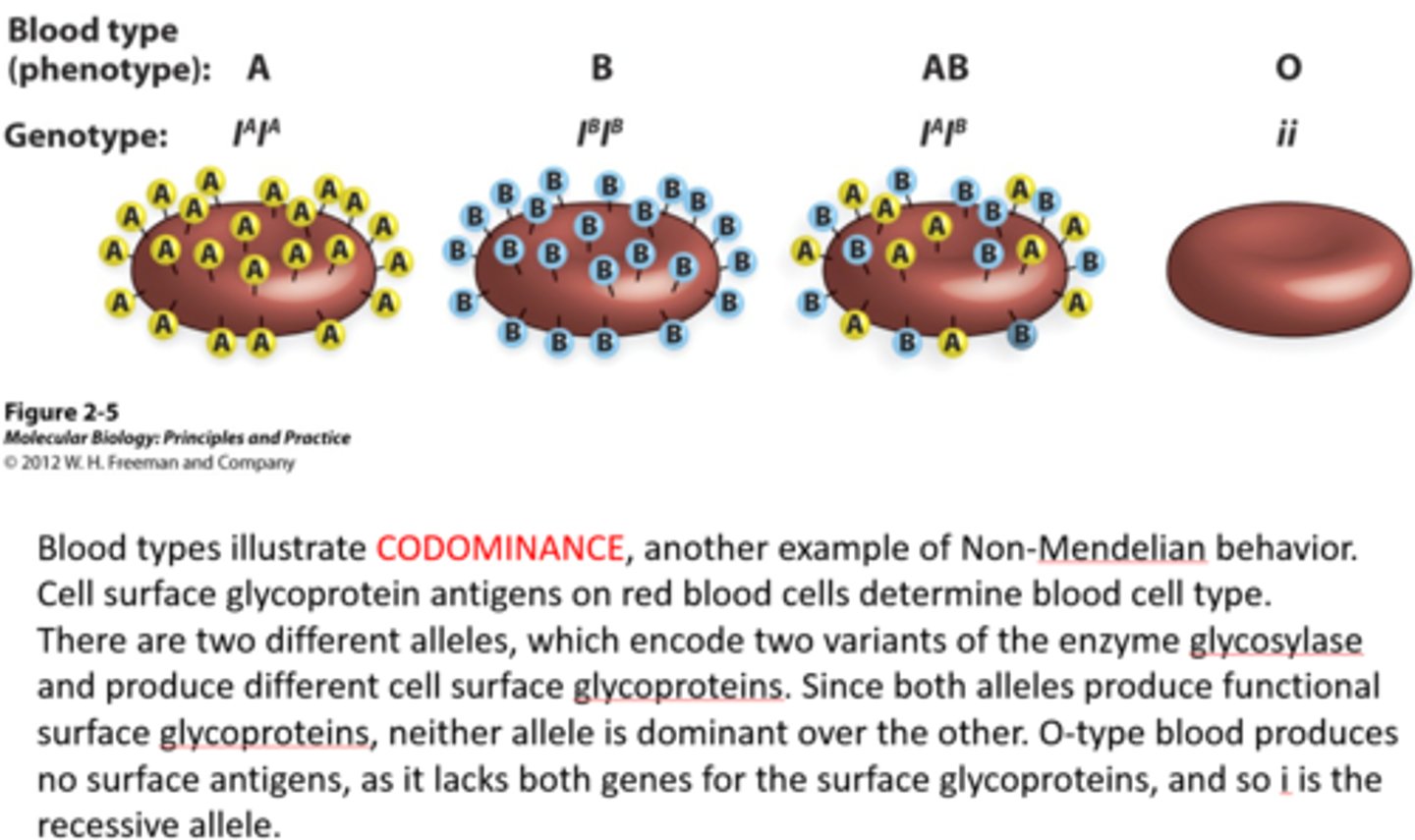
What are linked genes?
When two alleles for two different genes assort together in the gametes, rather than assorting independently. This happens because different some genes are relatively close to each other on chromosomes (breaks Mendel's second law)(pg. 31)
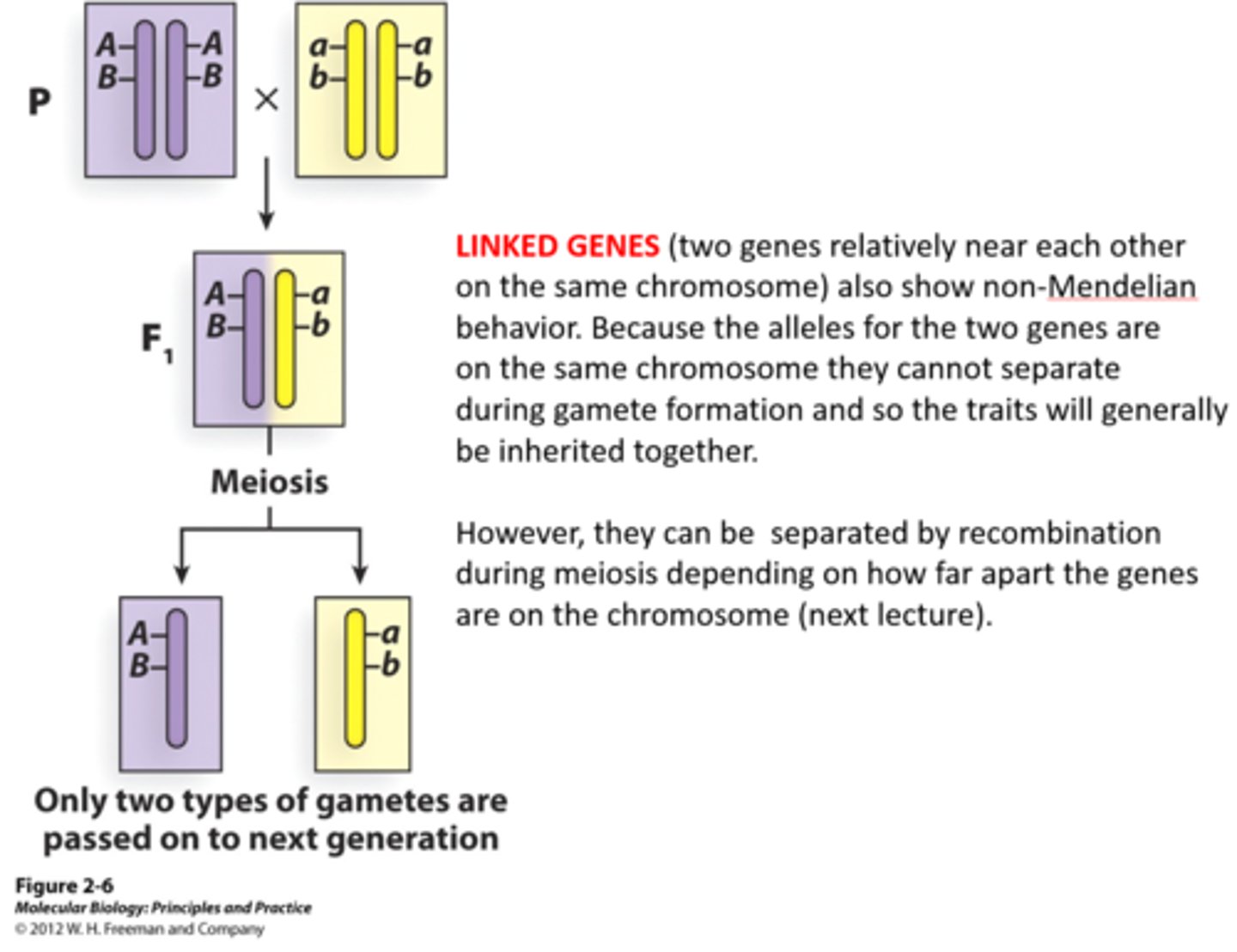
What are the three types of non-Mendelian inheritance?
incomplete dominance (pink flowers) codominance (blood type) and linked genes
What is the cell cycle?
G1, S, G2, and M (pg. 33)
G1 phase
cells are diploid. Cell is preparing for synthesis. G1 is the first gap before synthesis (S phase)(pg. 33)
S phase
Synthesis phase, chromosomes are duplicated. Ends with Tetraploid chromosomes (pg. 33)
G2 phase
second gap after S phase (pg. 33)
M phase/Mitosis
Mitosis. Duplicated chromosomes separate and the cell divides into two diploid daughter cells. Creates more somatic cells (pg. 33)
Interphase
Not mitosis (G1, S, and G2) (pg. 34)
Stages of Mitosis
Prophase (centrosomes move to opposite poles of the cell), metaphase (nuclear membrane breaks down, sister chromatid pairs line up in the middle), anaphase (sister chromatid pairs separate), telophase (cell divides/cytokineses) (pg. 34)

Meiosis
Makes gamete cells. Two cycles of cell division of a single diploid cell result in 4 haploid gamete cells (pg. 36)
Tetrad
Two pairs of homologous chromosomes are duplicated in S phase to produce two sister chromatid pairs. These two pairs form a tetrad during meiosis (pg. 36)
Sex chromosomes
X and Y chromosomes. Determine the gender of some species like mammals (pg. 37)
Autosomes
Not sex chromosomes (pg. 37)
What are homologous chromosome pairs?
Homologous chromosomes are chromosome pairs, one from each parent, that are similar in length, gene position, and centromere location. The position of the genes on each homologous chromosome is the same, however the genes may contain different alleles (google)
Chromosome theory of inheritance
Theory that genes located on chromosomes. Convincing evidence came from the experiments of Thomas Hunt Morgan and his fruit flies. (pg. 38)
Wild type traits
The allele that appears with the greatest frequency in a natural population of a species (pg. 38)
Mutant traits
Alleles that aren't wild-type (pg. 38)
nondisjuntion
the abnormal assortment of chromosomes during meiosis (pg. 40)
How is Mendel's second law not quite right?
Chromosomes, not individual genes segregate into gamete cells (pg. 40)
Linked Genes
Because chromosomes, not individual genes, segregate into gamete cells, genes that are close together on a chromosome tend to be linked (pg. 40)

Testcross
pg. 40
Unlinking genes
Linked genes become unlinked through recombination/crossing over (chiasma) (pg. 40-41)
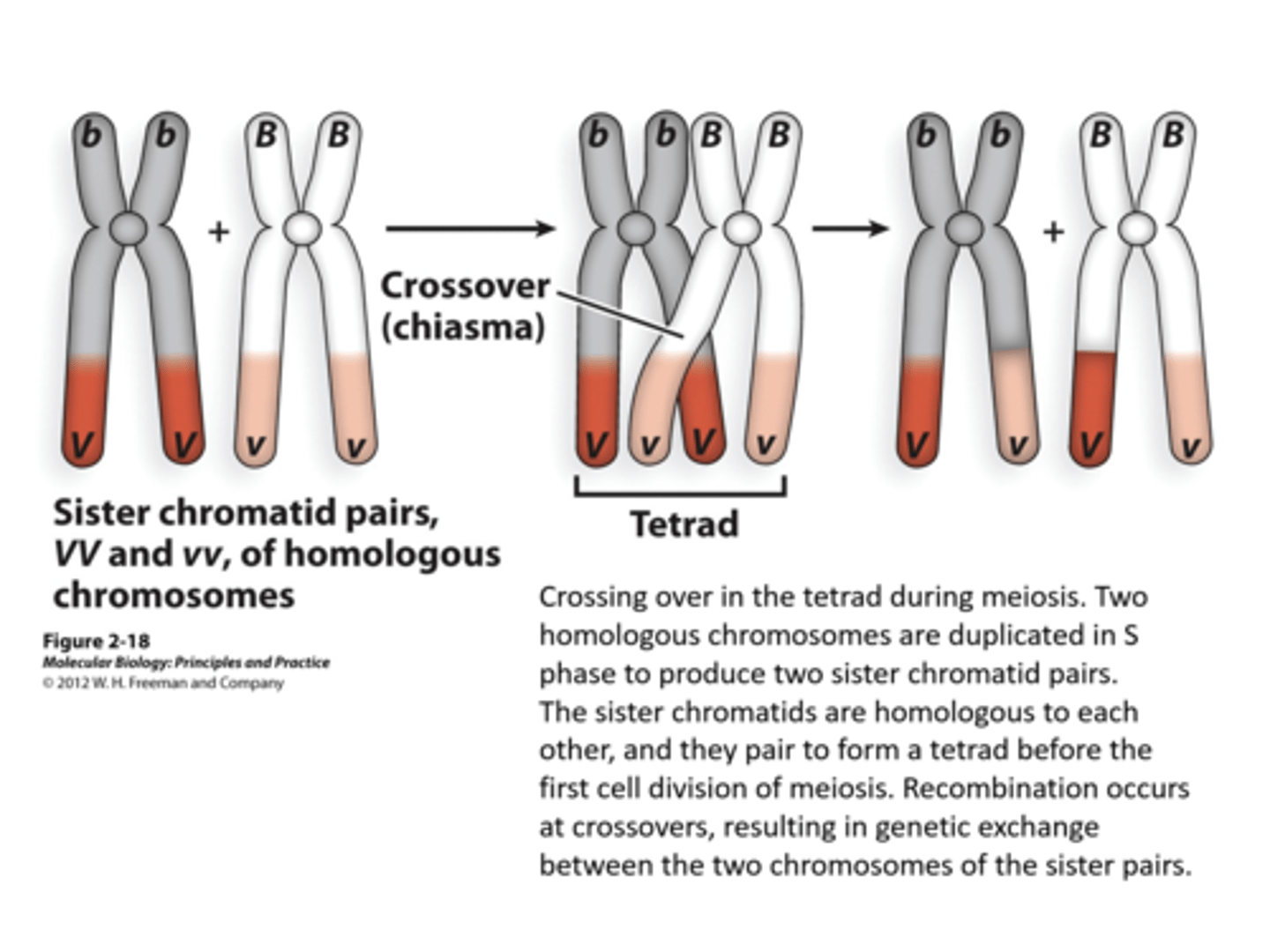
Crossing over/recombination
When chromosomes exchange genetic information during meiosis
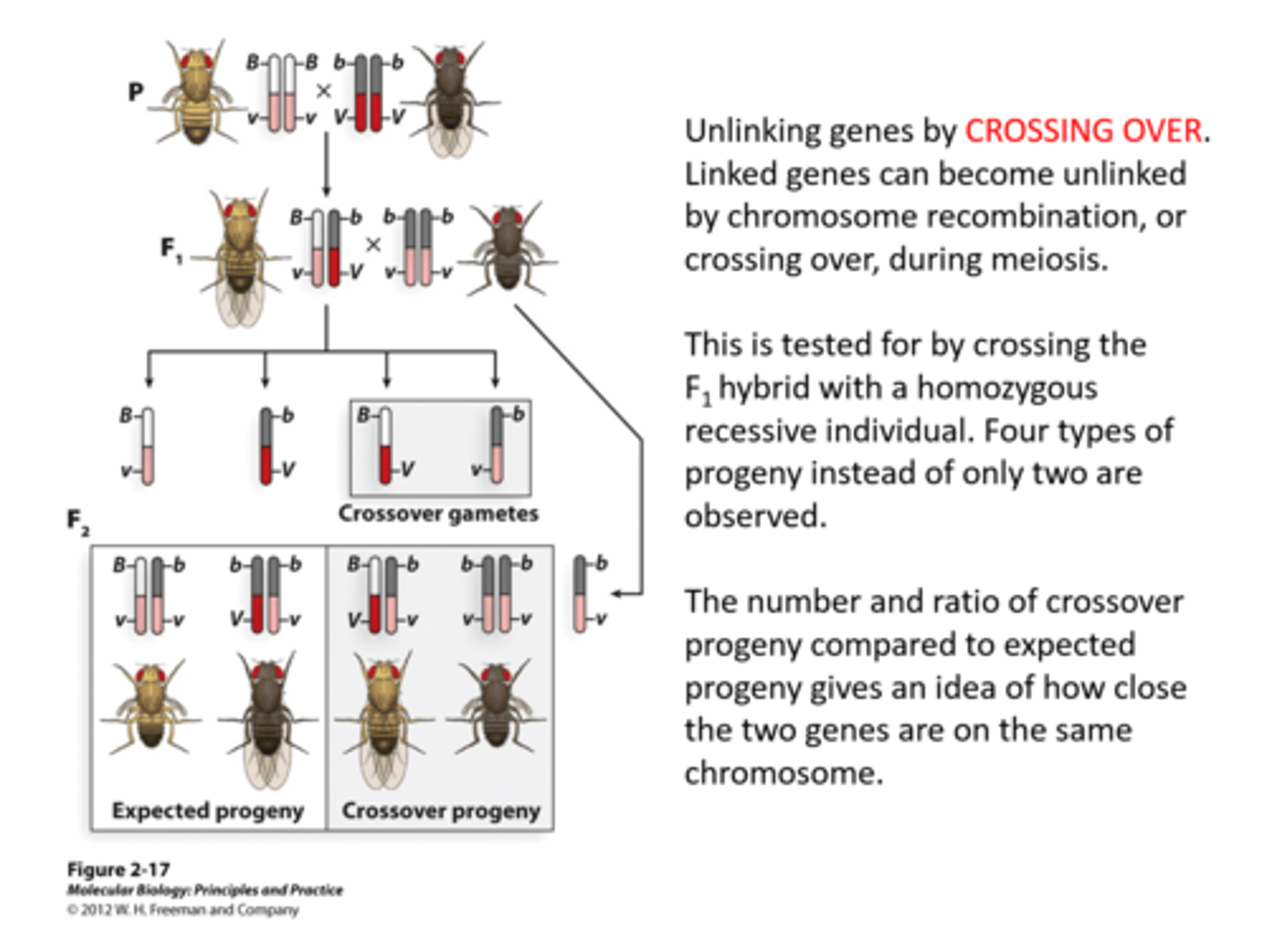
Meiotic Recombination
The reciprocal exchange of alleles between chromosomes (tetrads) during meiosis (pg. 41)
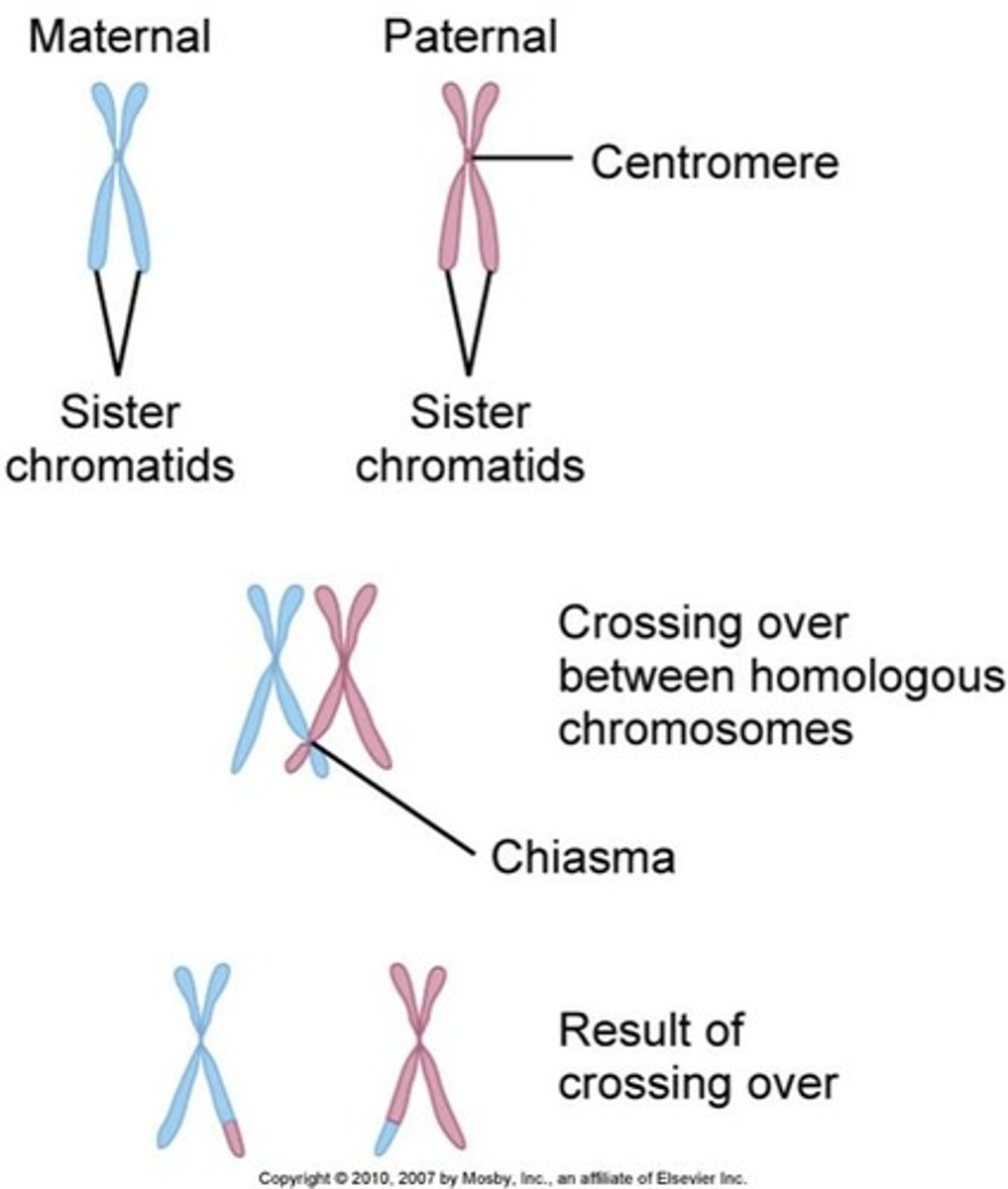
How are genes mapped?
By testing recombination frequency/recombination mapping. Recombination can be used to generate genetic maps. The maps are based on the frequency of crossing over between many pairs of linked genes. The higher the frequency of recombination, the further
apart the genes are on the chromosome.
The lower the frequency, the closer the
two genes are.
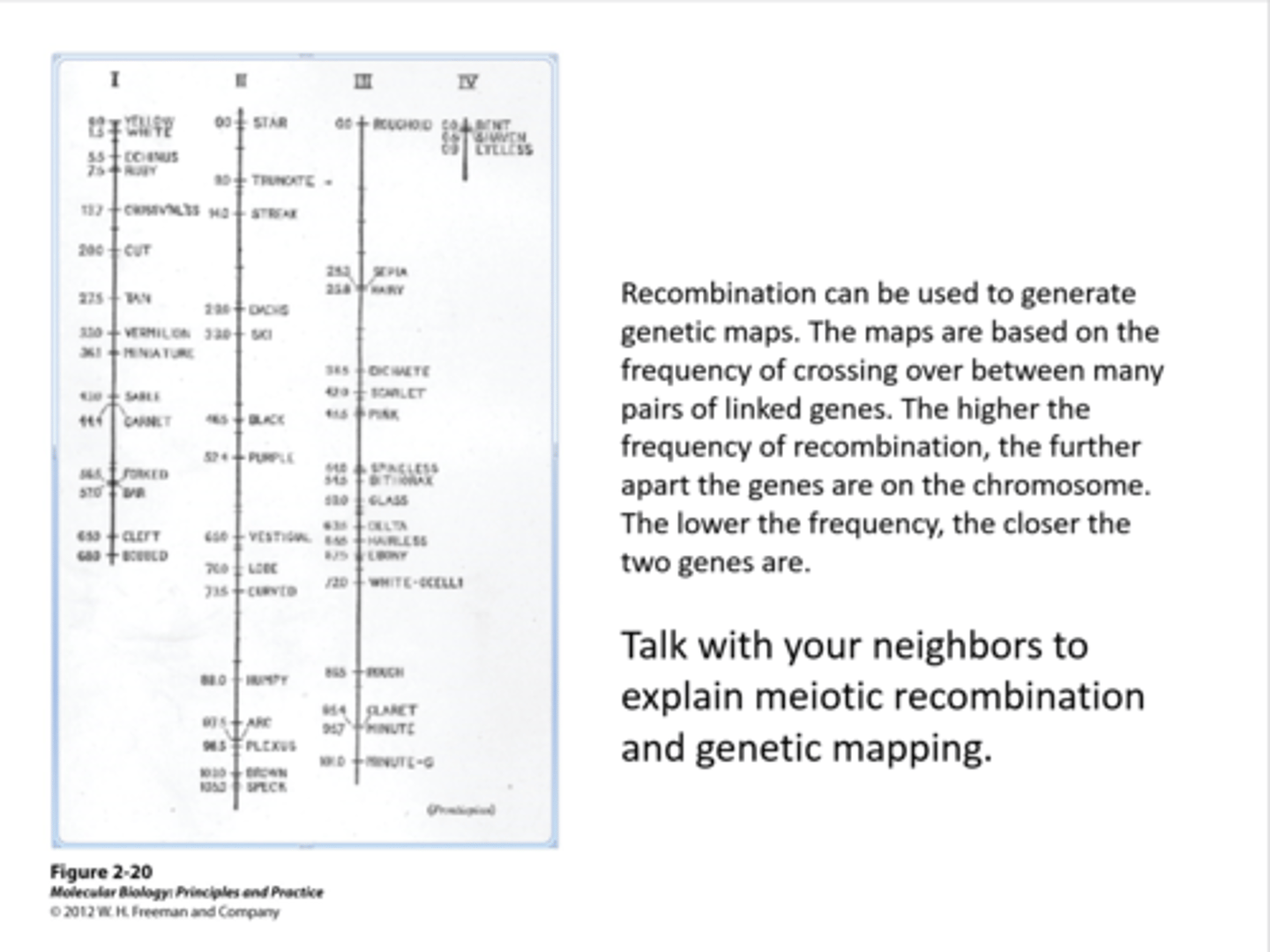
Molecular Biology
The fusion of genetics and chemistry
Deoxiribonucleic acid (DNA)
The chemical of heredity. Contain nitrogenous bases that code for genes: adenine/guanine and cytosine/thymine (pg. 44)
Nitrongenous bases of Ribonucleic acid
adenine/guanine and cytosine/uracil (pg. 44)
Avery/Griffith experiment
A scientist called Oswald Avery did experiments with pneumonia-causing bacteria. The smooth, virulent (disease causing) strains were heat killed and then mixed with the rough, nonvirulent smooth strains. The rough strain took up the DNA of the heat-killed smooth strain and became virulent. They also mixed DNase-treated smooth stain with the live rough strain and injected this into the mouse and the mouse lived. This showed that DNA is the chemical of heredity (pg. 45)
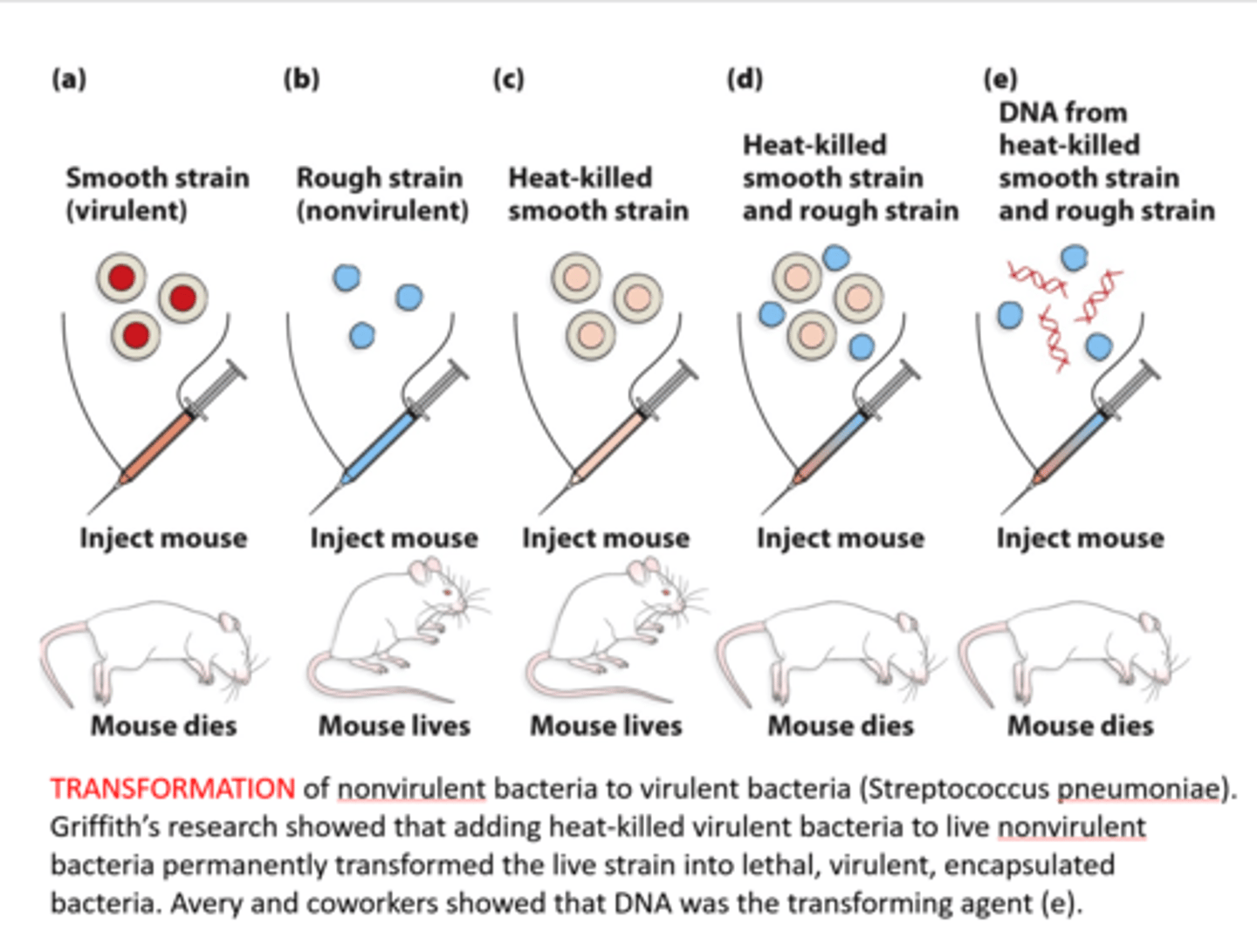
Enzymes
a protein catalyst that facilitates reactions (pg. 46)
Auxotroph
A mutant organism defective in the synthesis of a particular biomolecule, which must therefore be supplied for the organism's growth (pg. 46)
Polypetide
a chain of amino acids (pg. 47)
Watson and Crick
Discovered DNA structure. Using data from other scientists, they determined that two strands of DNA wound about one another in a spiral, double helix. Each strand has nitrogenous base pairs (adenine, thymine, cytosine and guanine). This helped solve the mystery of DNA replication and transcription (pg. 47-48)
Transformation
transformation is the genetic alteration of a cell resulting from the direct uptake and incorporation of exogenous genetic material (exogenous DNA) from its surroundings through the cell membrane(s).
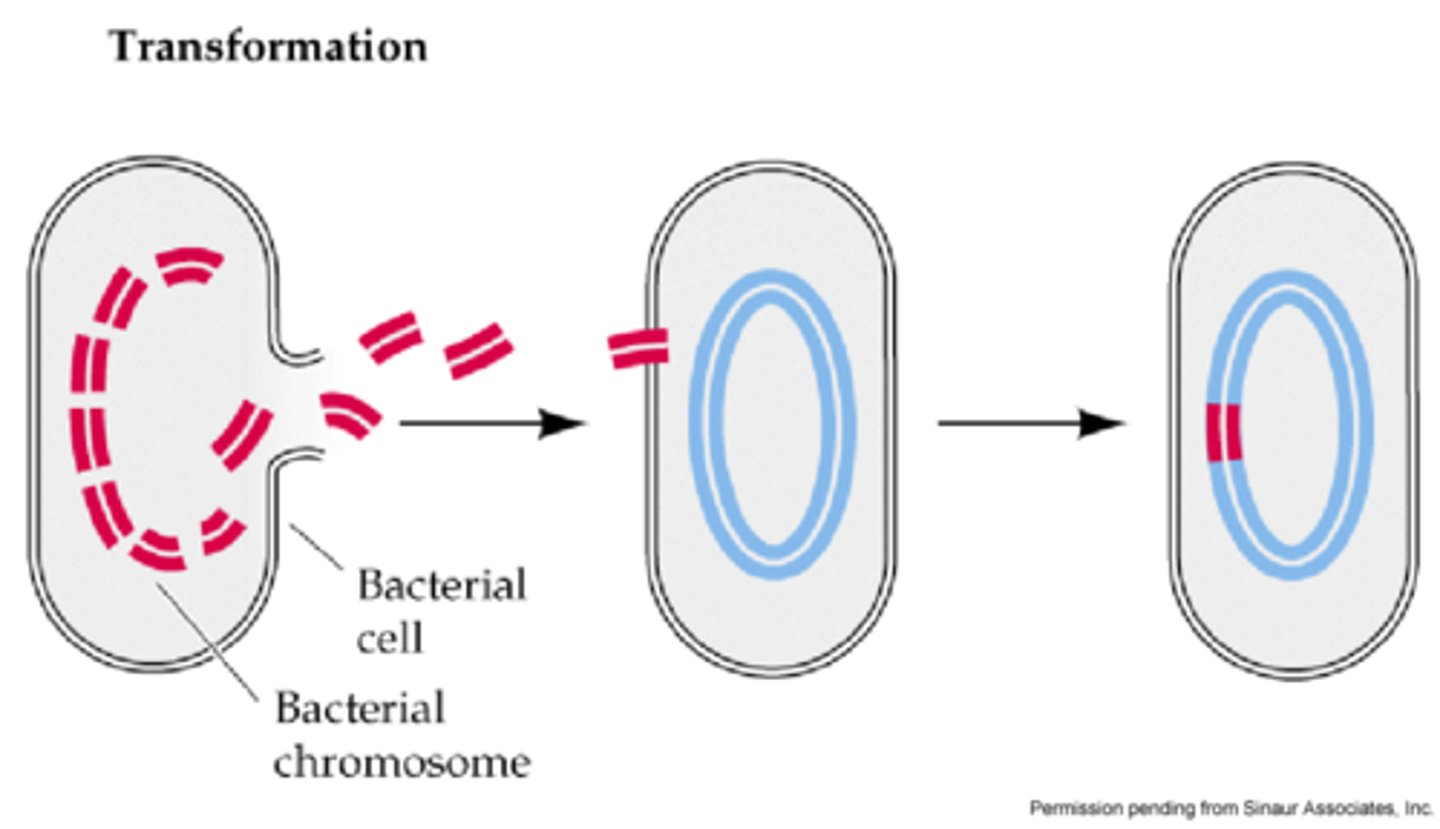
Overview of Hershey and Chase experiment.
They labeled two bacteriophages (a bacterial virus), one on it's protein coat and the other it's DNA core. They then infected cells with these two differently labeled bacteriophages. They blended and centrifuged the culture and showed that the labeled protein coat stayed in the supernatant while the labeled DNA was transfered to the pellet containing the cells. This showed that DNA is the genetic material (pg. 58)
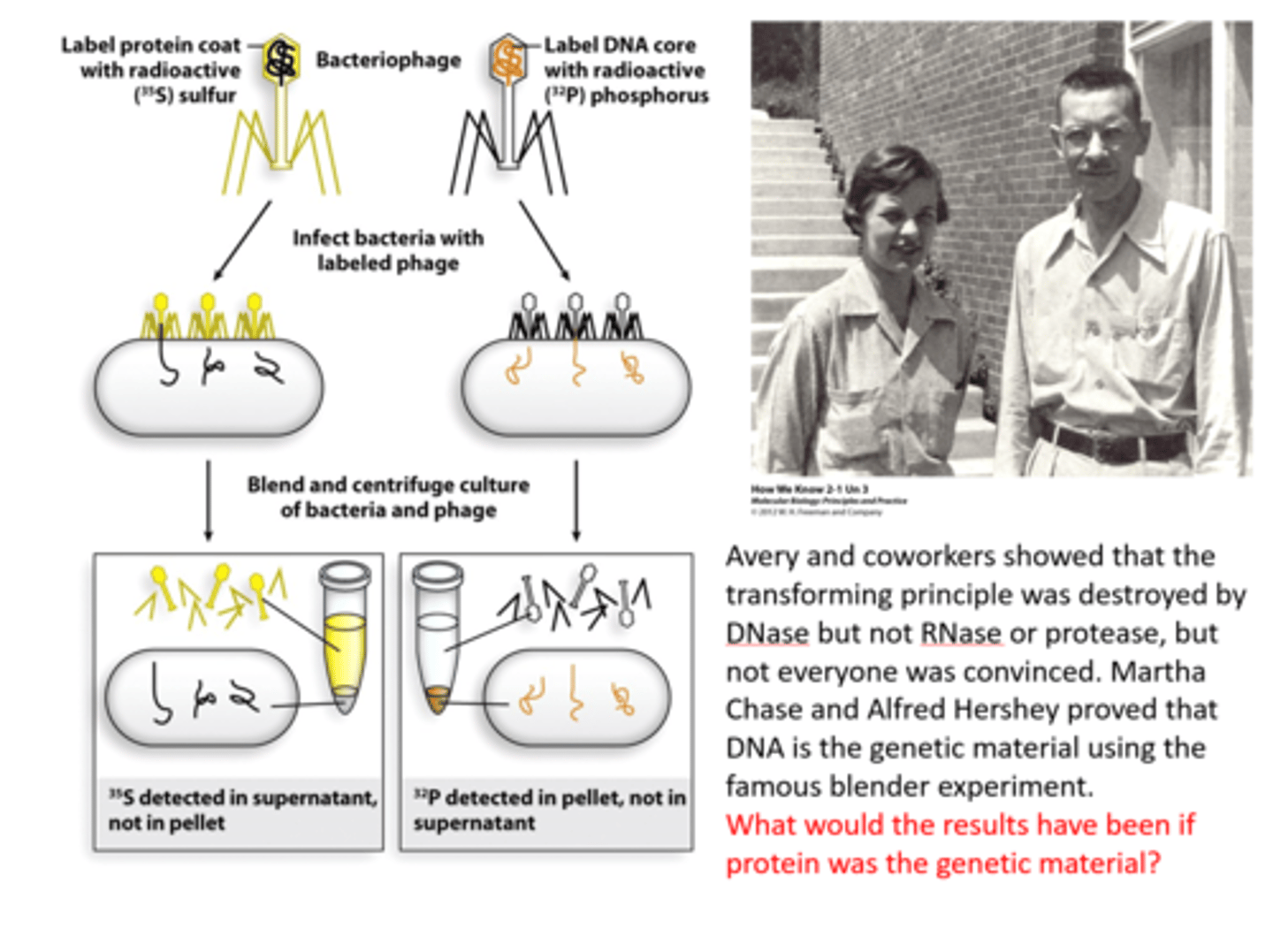
How did we come to know that DNA was the source of genetic information?
Avery/Griffith experiment and Hershey/Chase experiment
One gene, one enzyme/protein hypothesis
Beadle and Tatum, through their experiments proposed that each gene codes for one enzyme. Later revised to one gene, one polypeptide hypothesis (pg. 47)
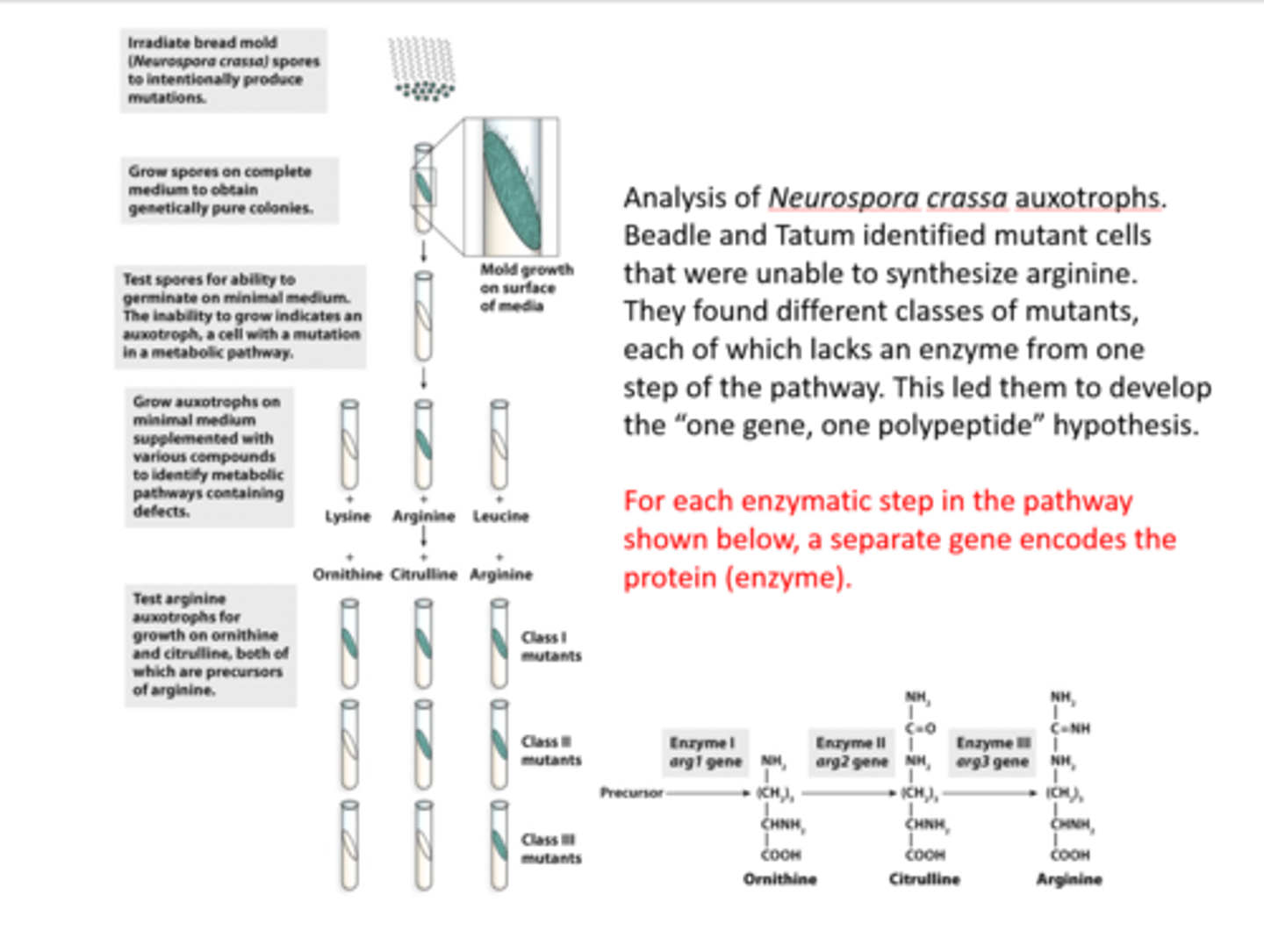
Dnase, RNase, protease
Enzymes that can break down DNA, RNA, and proteins respectively (pg. 46)
Complementary nucleotide base pairs in DNA/RNA
DNA: Adenine/thymine, cytosine/guanine. RNA: adenine/uracil, cytosine/guanine (pg. 48)
Central dogma
DNA→RNA→protein (DNA is transcribed into RNA which is translated in proteins)(pg. 48)
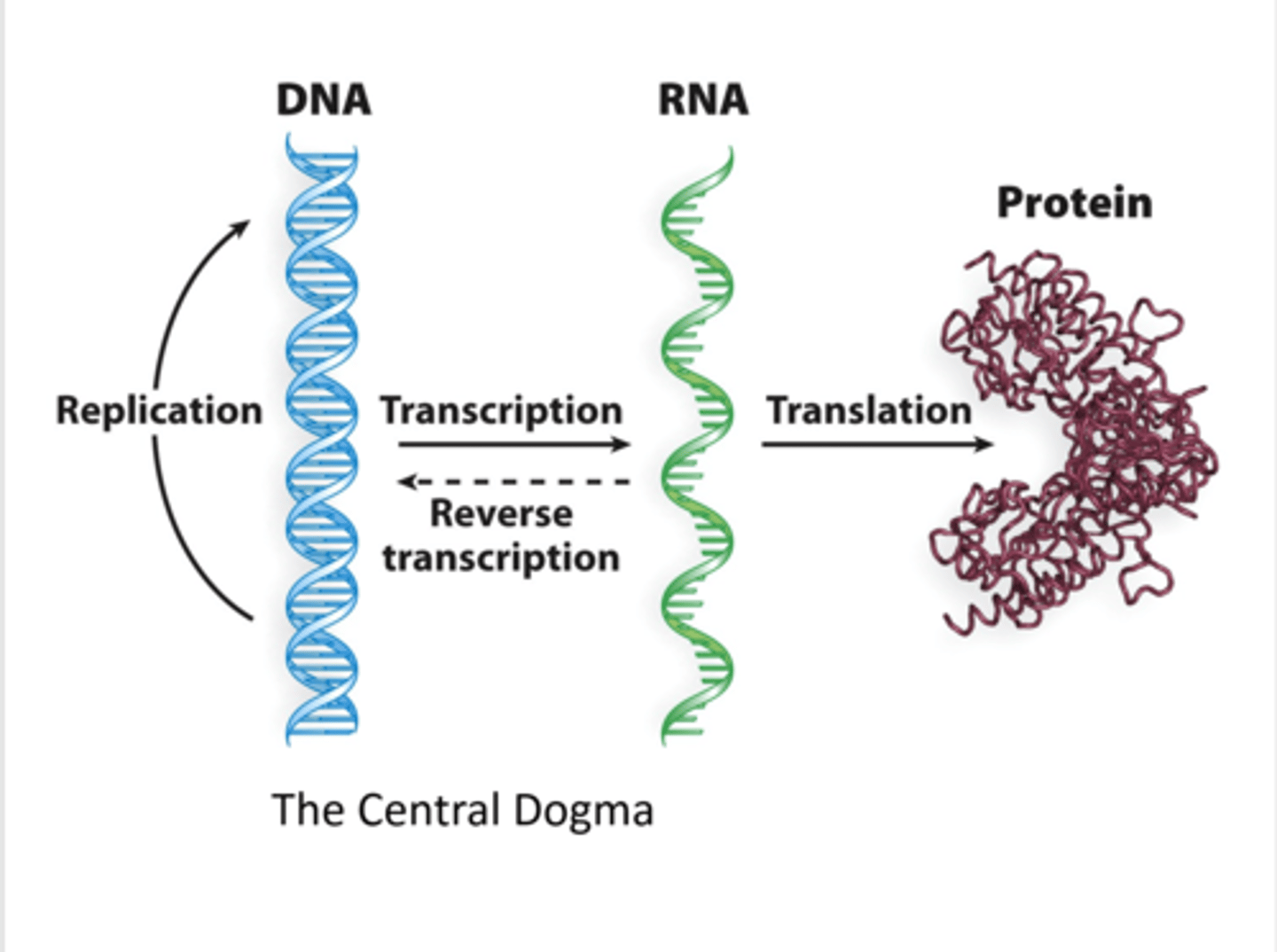
Exceptions to the central dogma
Certain enzymes can synthesize DNA from RNA (RNA→DNA) and some viruses use RNA as a template to make more RNA (RNA→RNA)(pg. 48)
Ribosomal RNA (rRNA)
Responsible for protein synthesis. Located on rough endoplasmic reticulum.

Messenger RNA (mRNA)
Temporary copies of DNA. Formed from RNA polymerase during DNA transcription (pg. 48)
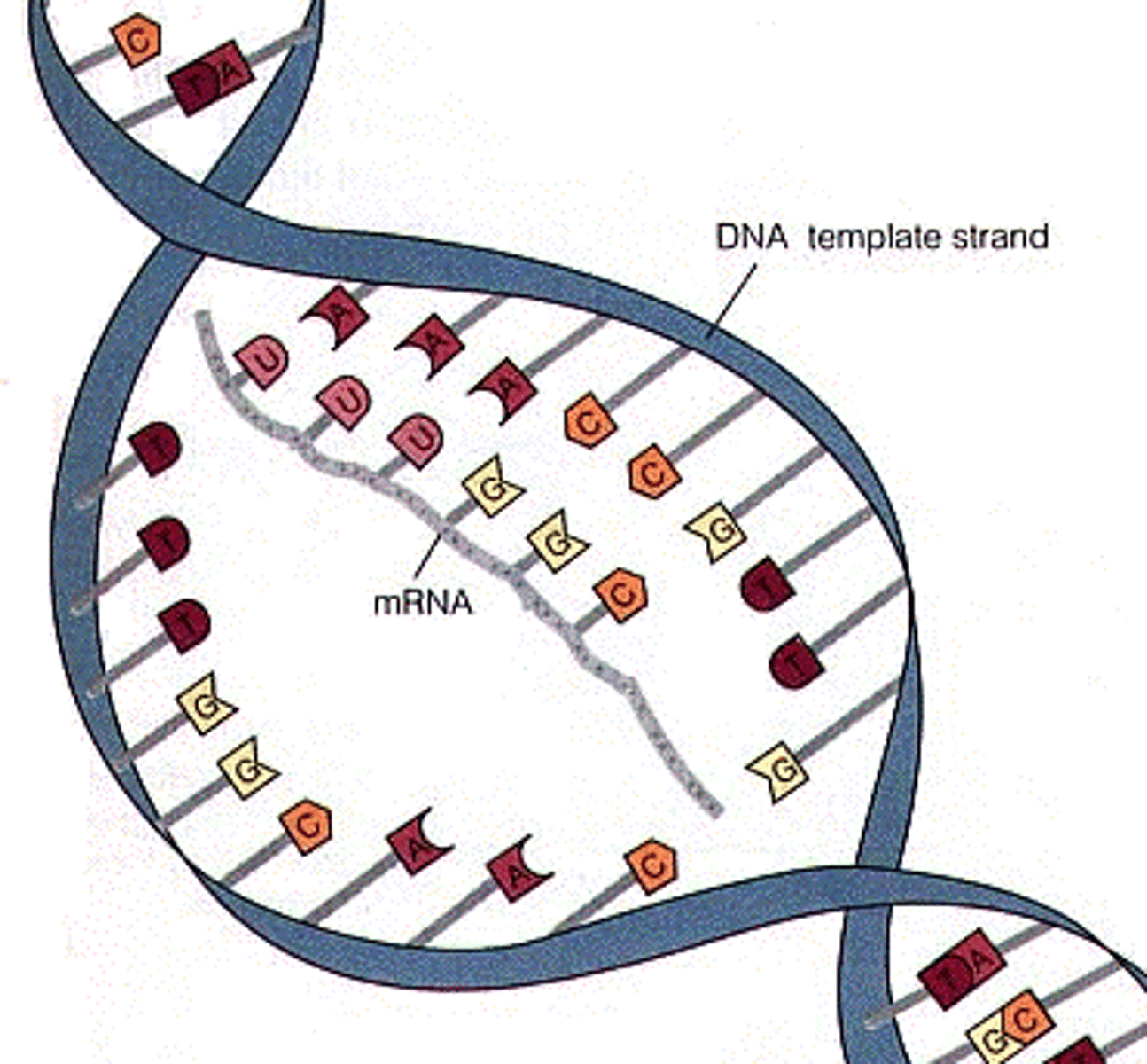
RNA polymerase
Transcribes DNA into mRNA (pg. 49)
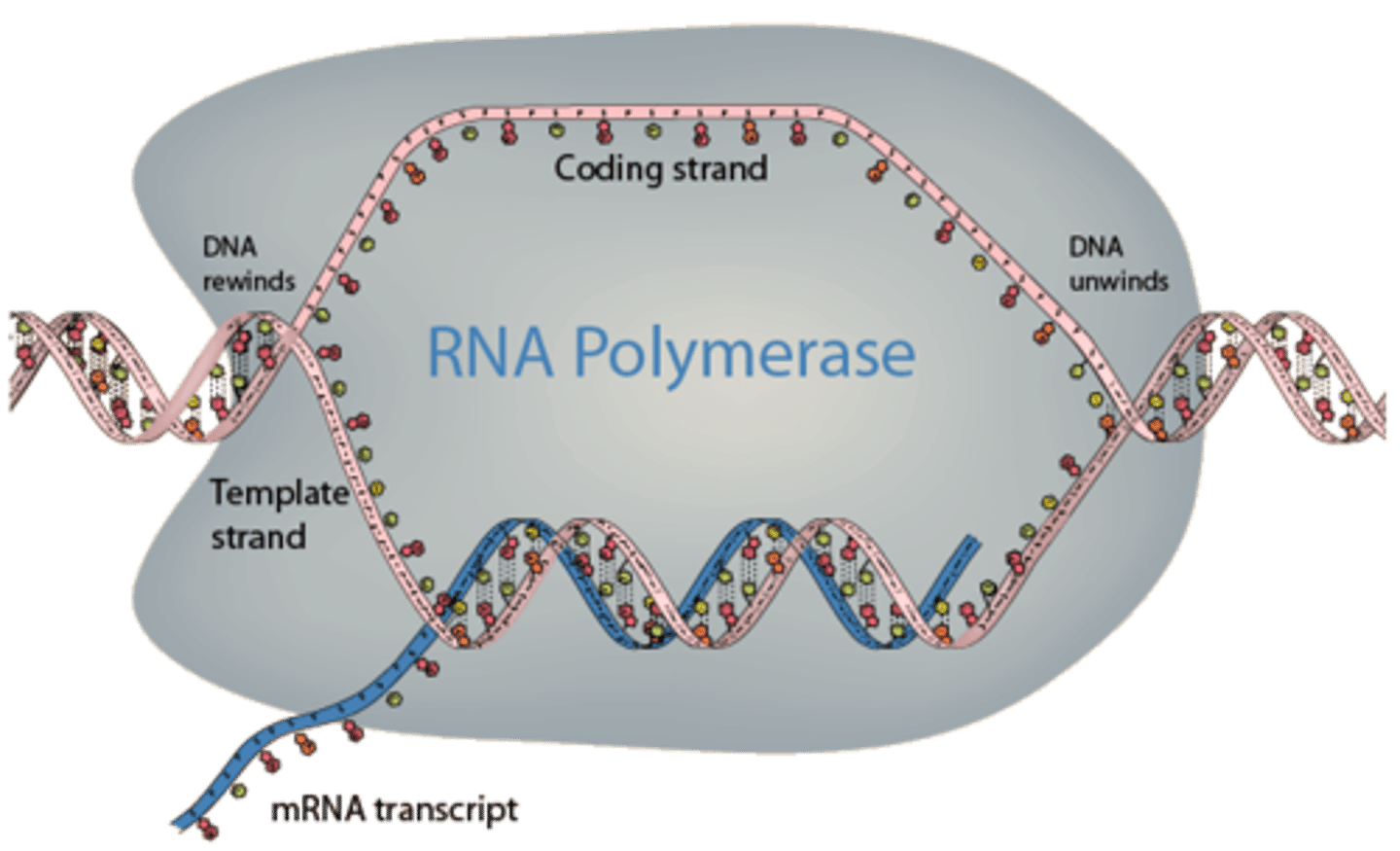
Transcription
The process of making single-stranded RNA copies of a DNA strand (pg. 49)
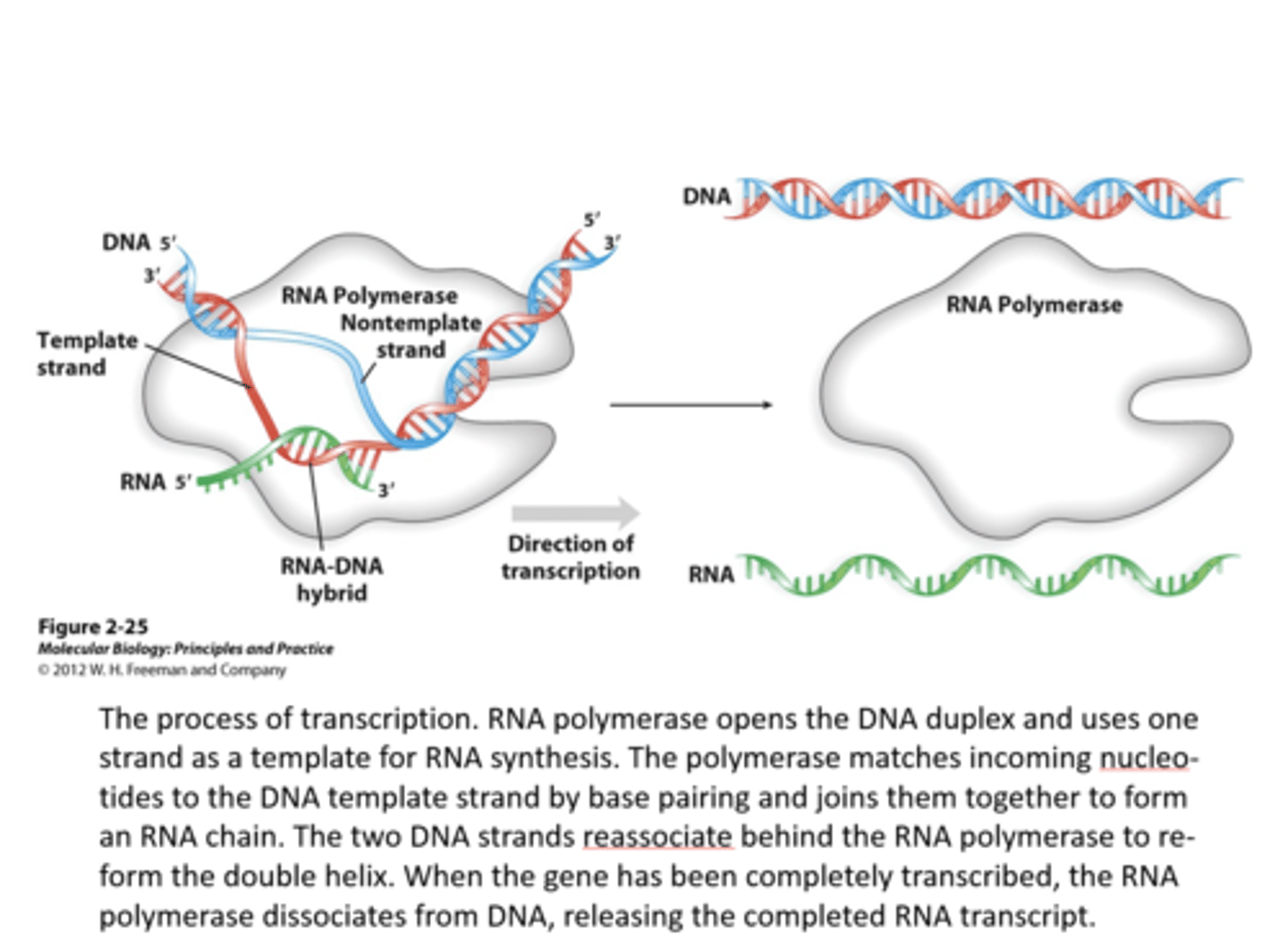
Transfer RNA (tRNA)
The adaptor between nucleic acid and protein. Three bases in the tRNA form base pairs (codons) with a triplet sequence in the mRNA (pg. 49)
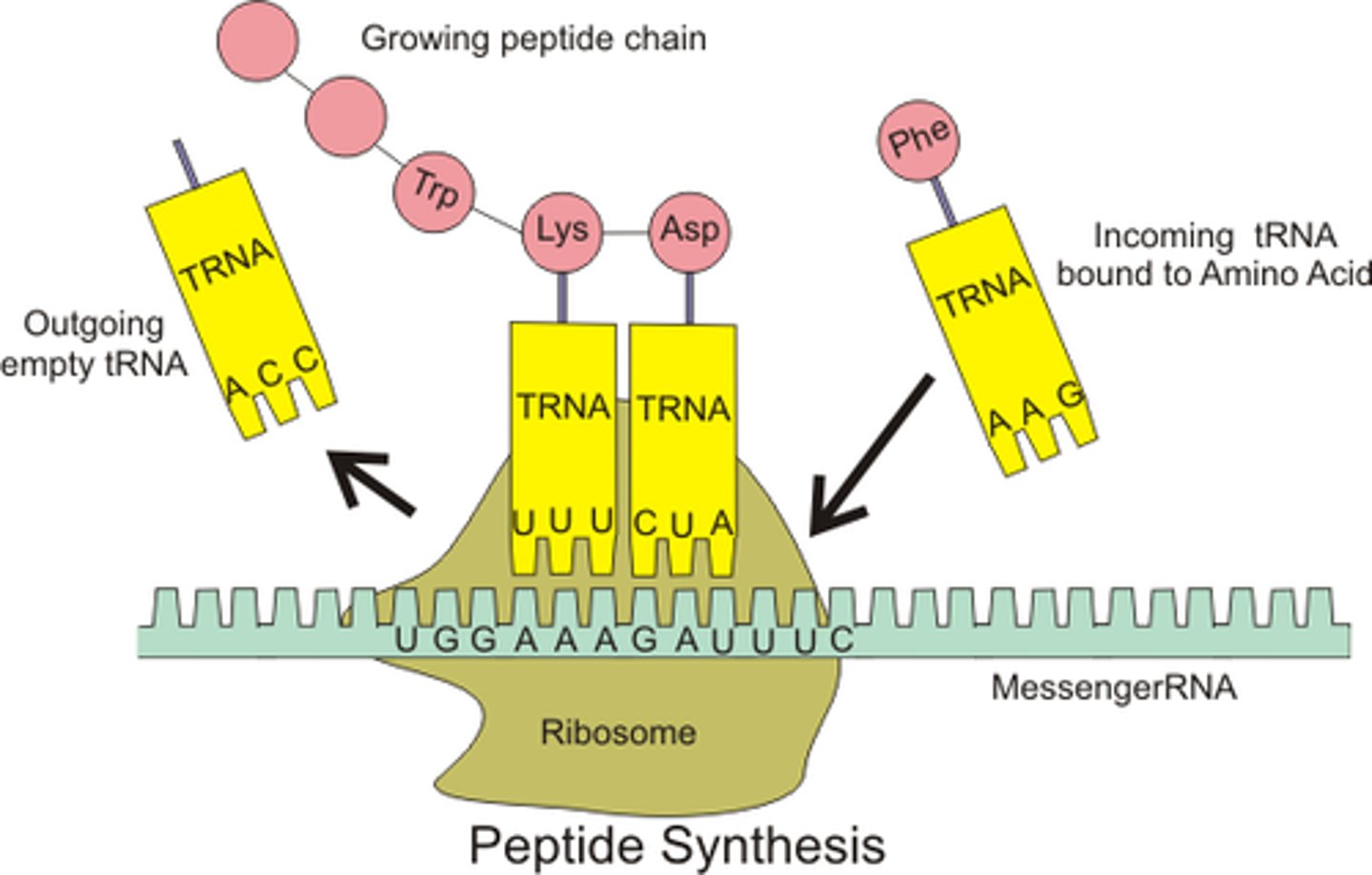
Translation
The overall process of protein synthesis, involving three types of RNA molecules (pg. 49)
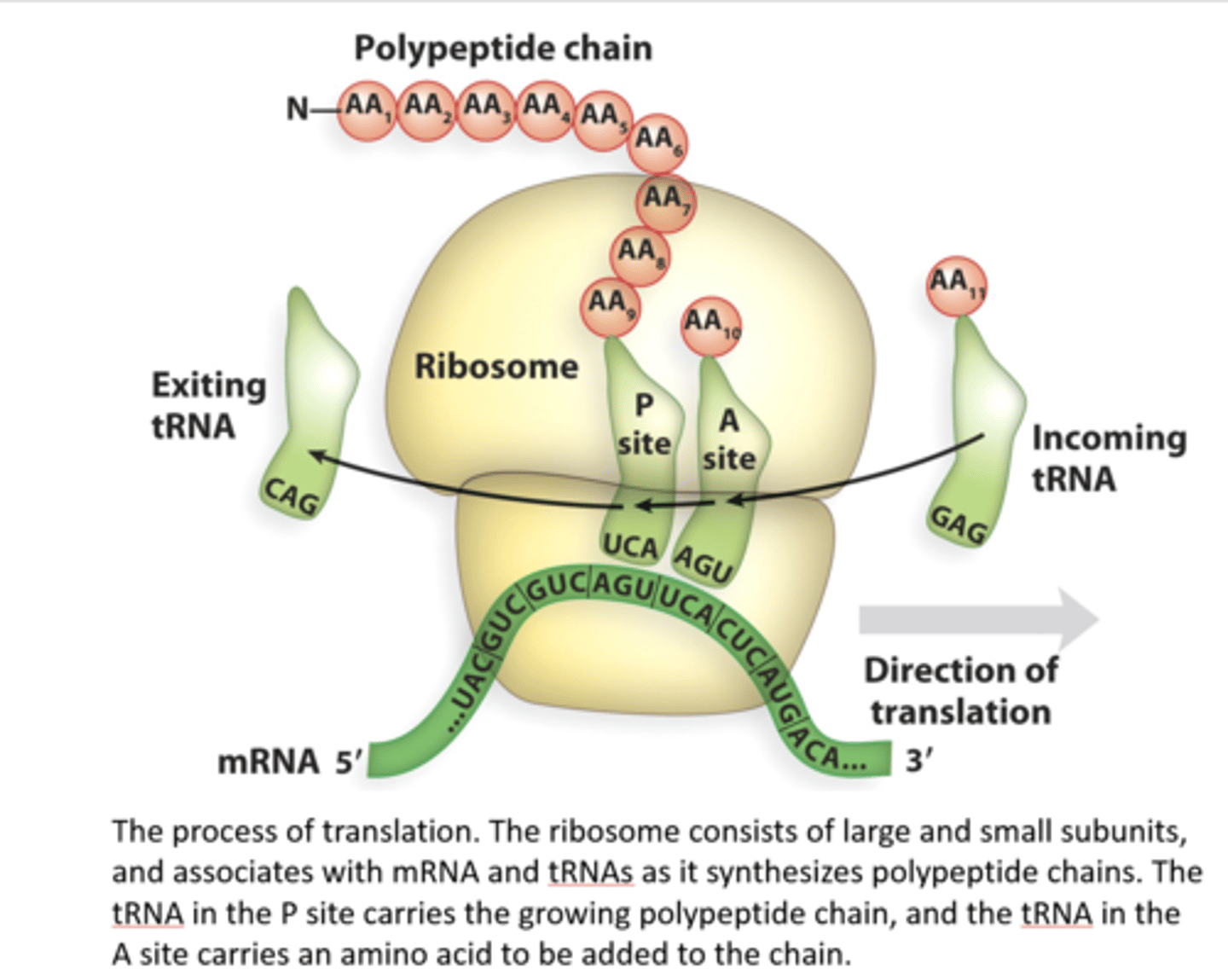
functional RNAs
non-coding RNAs (ncRNA) are transcribed from DNA but not translated into proteins. Examples are rRNA and tRNA (pg. 49)
Mutation
Beneficial or harmful (or silent) changes to an organism's DNA. These help fuel evolution and natural selection because they provide diversity and advantages/disadvantages.
Hemophelia
A sex-linked recessive genetic disease (10,000 times more common in males than females) that leaves the blood unable to clot resulting in excessive bleeding even from minor cuts. The gene regulating clotting factors is on the X chromosome (not the Y). A mutant of this gene causes hemophilia. If the male has the recessive mutant allele, he will have hemophilia (called a hemophiliac. also males cannot just be carriers). If a female has one normal allele and one mutant allele, the normal allele masks the affects of the mutant and she is only a carrier. Females are hemophiliacs if they have two copies of the mutant allele (are homozygous recessive) (see figure 2-27 pg. 50-51)

Hemophilia is a non-Mendelian trait
Sex-linked inheritance involves genes that are on the X-chromosome. Females have 2 X-chromosomes, like all the other chromosomes, but males have only a single X-chromosome.
In general, we have 2 doses of the gene for any particular trait - the 2 doses may or may not be the same. But for any gene that is on the X-chromosome, females have the usual 2 doses, but males have only 1 dose of that gene.
Therefore, if a male's single dose is the abnormal version of the gene, then the trait will be abnormal in that male. So it only takes a single dose of an abnormal gene to make a male abnormal. But because a female has 2 X-chromosomes, she may also have the normal version of the gene, which may dominate the abnormal one and produce the normal trait.
So more males than females show abnormal traits for genes that are located on the
X-chromosome. Just by chance, all the genes that Mendel worked with were present in 2 doses, so he never saw this sex-linked deviation.
Genetic disease
A disease that is passed genetically from parents to progeny
Huntington disease
A genetic autosomal dominant neurological disease. Does follow Mendelian inheritance pattern (pg. 51)
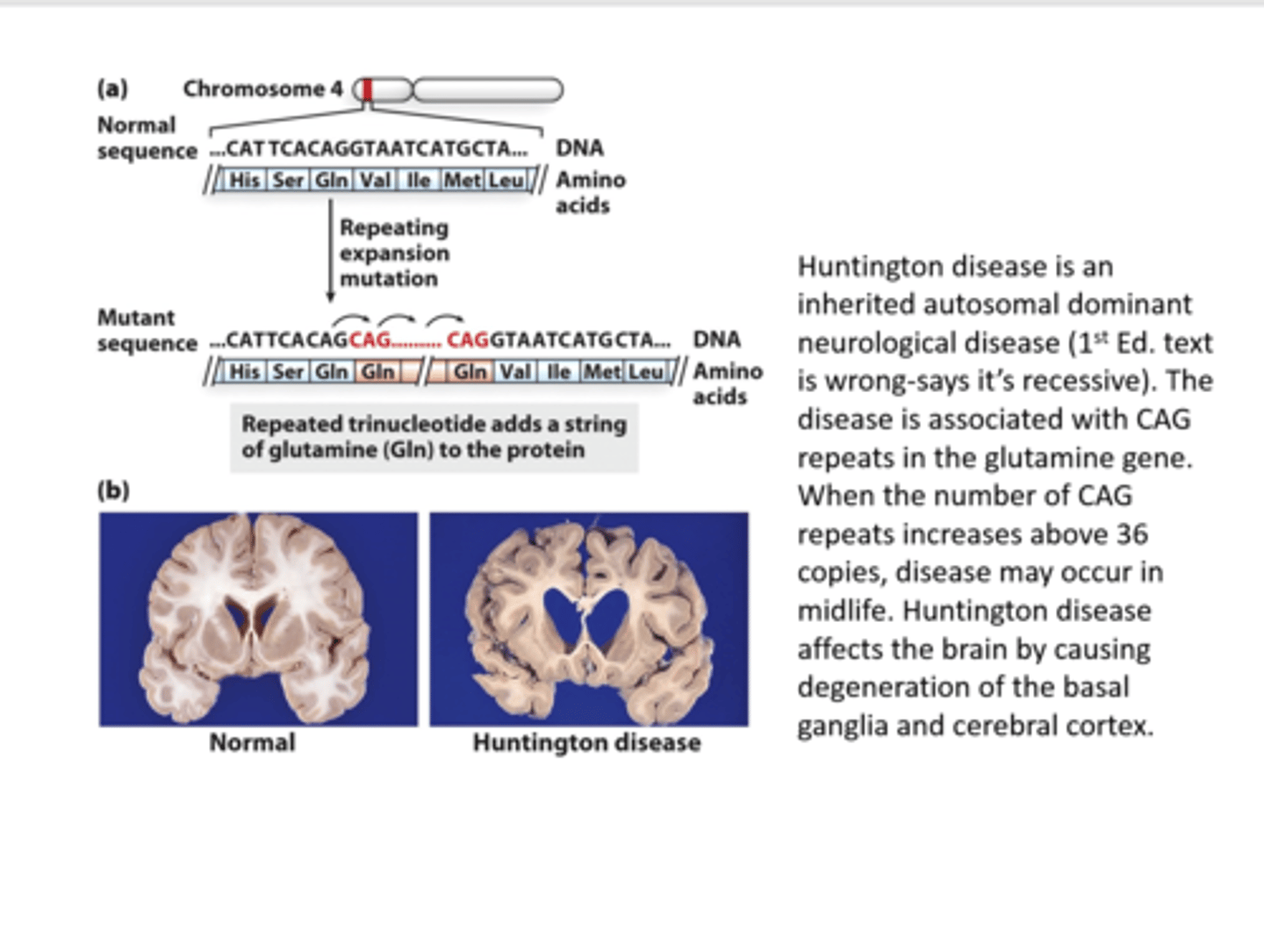
Does Huntington disease follow a Mendelian inheritance pattern?
Yes
Description of what causes Huntington disease
powerpoint
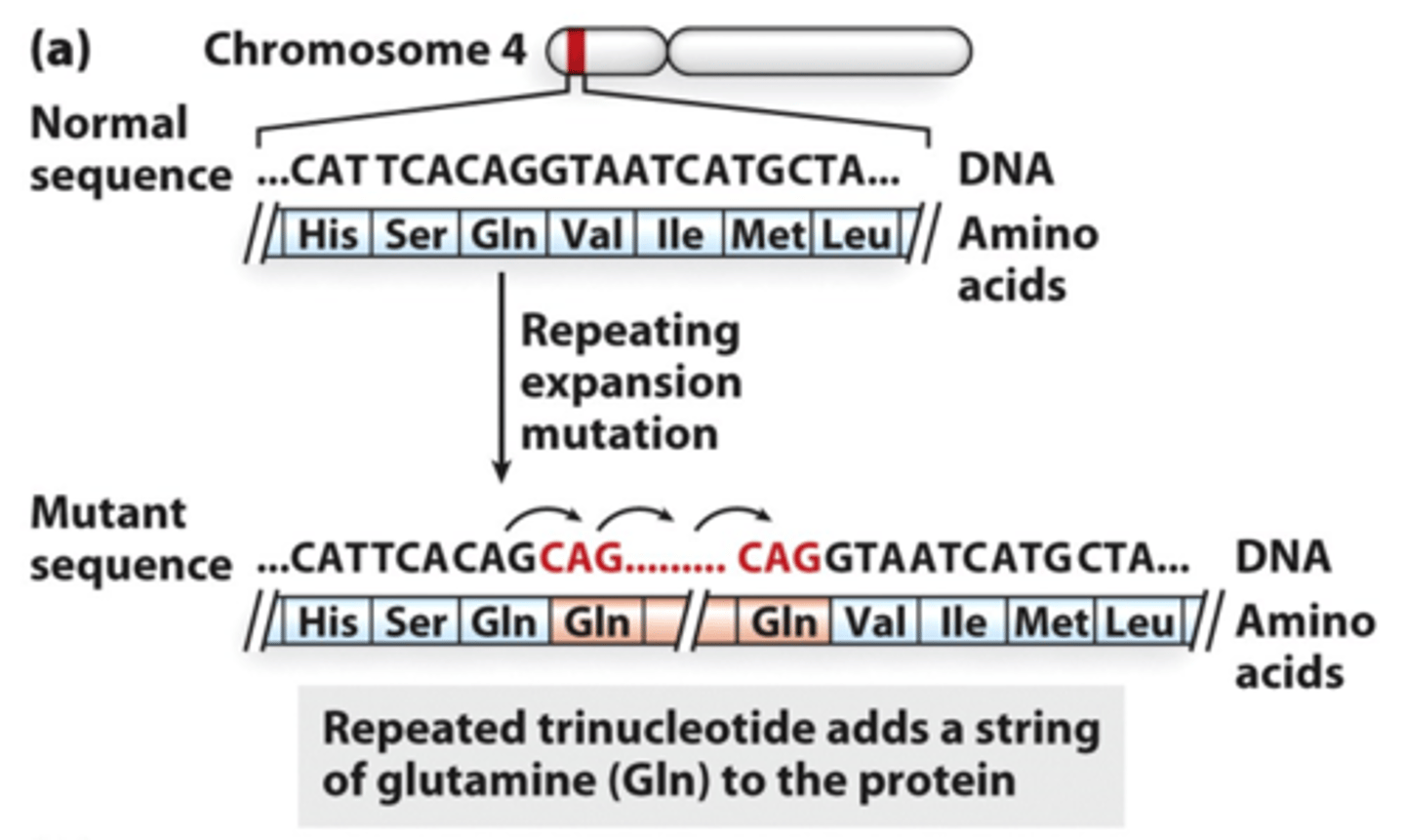
Sickle-cell anemia
A recessive genetic disease that is caused by a mutation in the hemoglobin (the oxygen carrying protein of red blood cells) protein. Blood cells become misshapen and can get stuck in capillaries and impede blood flow. Heterozygous individuals (with one normal and one mutant allele) have nearly normal blood. Is considered a Mendelian trait (pg. 52)
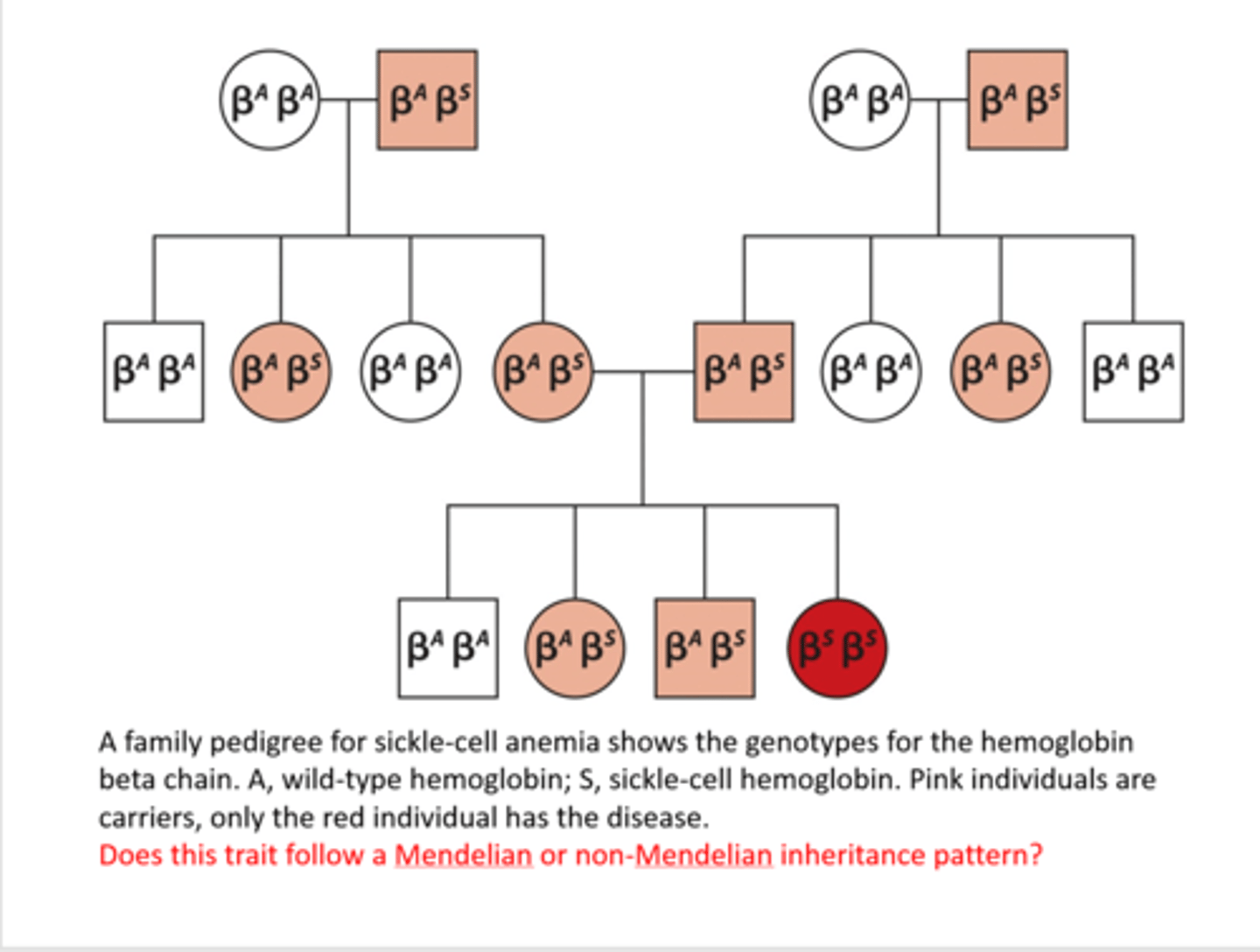
Description of the mutation causing sickle-cell anemia
A single nucleotide change in the sickle-cell allele alters the hemoglobin beta chain.
In hemoglobin S, the most common substitution is a T for the A in triplet 6 to form a CTG triplet, which changes the codon to valine (pg. 52)
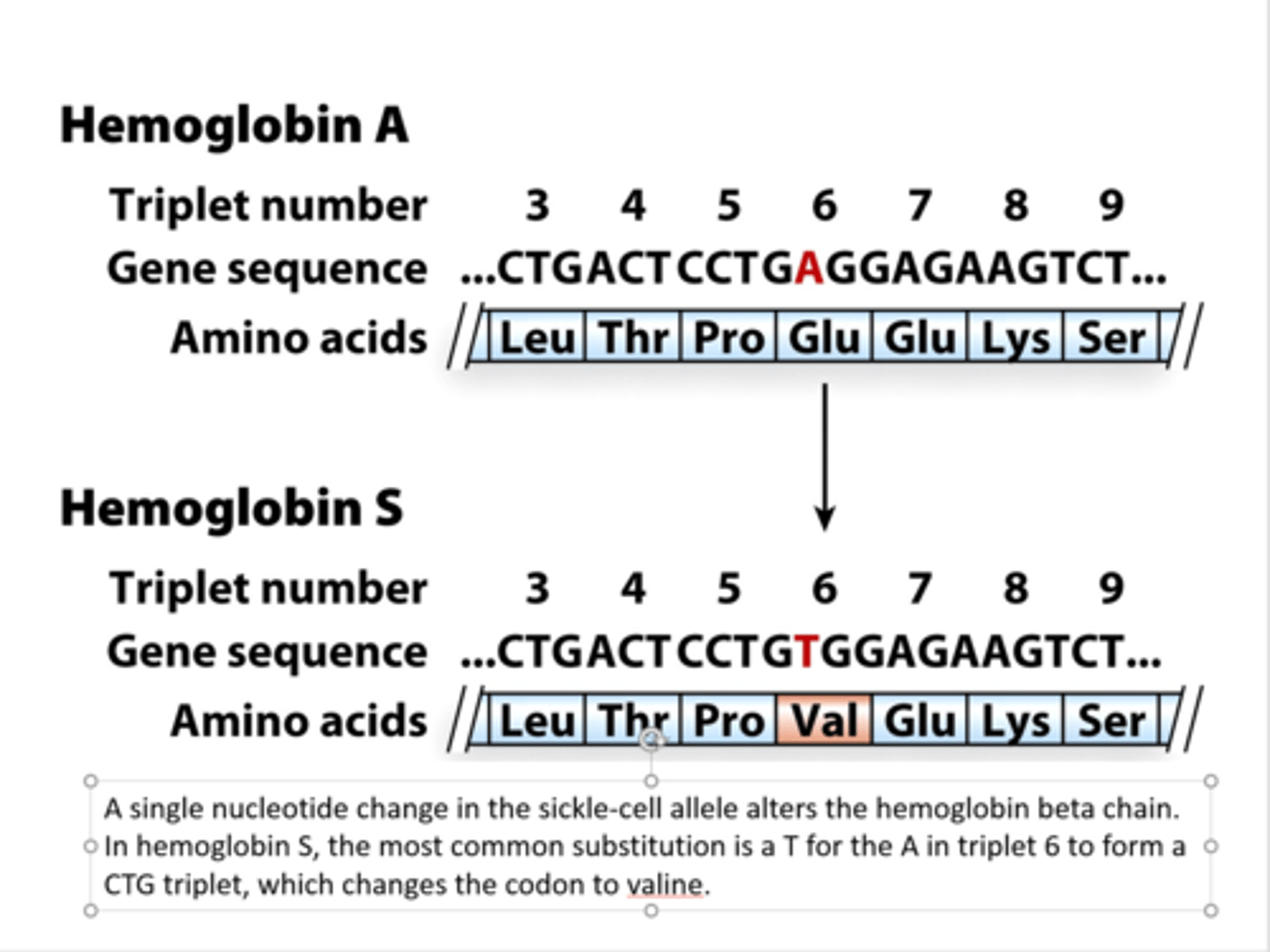
What is cystic fibrosis. What causes it?
A autosomal recessive genetic disease that is caused by a mutation that affects the function of a chloride ion channels. Individuals with cystic fibrosis develop abnormally high sweat and mucus production which can lead to pneumonia. It's caused by deletion of three nucleotides that code for phenylalanine (F). This leads to improper folding of a protein that plays an important role in chloride ion channels (pg. 53-54)
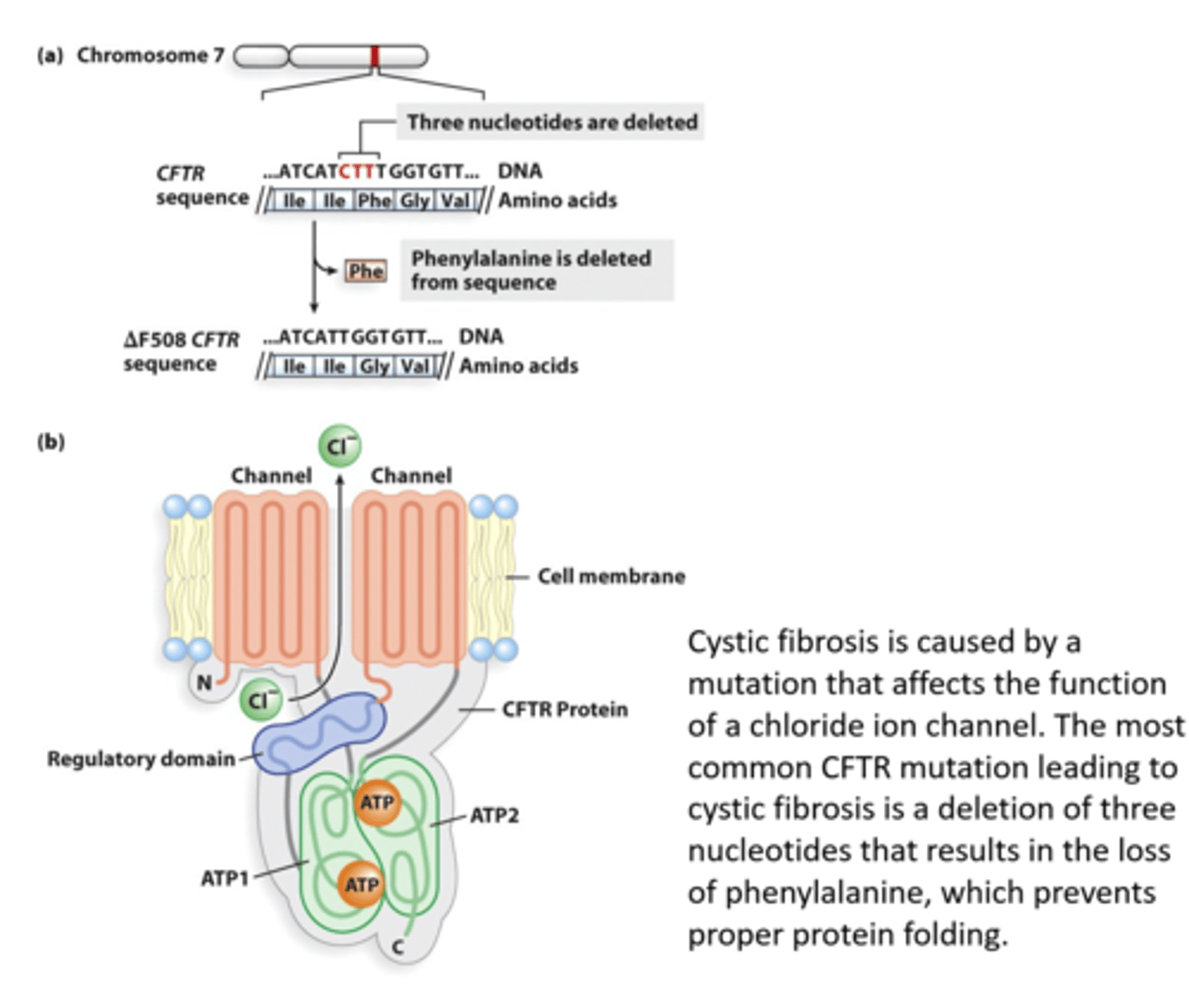
Is Cystic fibrosis a Mendelian trait?
Yes (google)
What causes cystic fibrosis?
The most common CFTR mutation leading to
cystic fibrosis is a deletion of three nucleotides that results in the loss of phenylalanine, which prevents
proper protein folding (powerpoint)
Autosomal vs. X-linked disease
Autosomal diseases are genetic diseases that are associated with autosomes. X-linked diseases are genetic diseases associated with the sex chromosomes.
How are inherited genetic diseases characterized?
Can be autosomal/X-linked